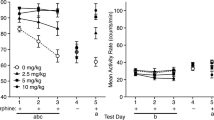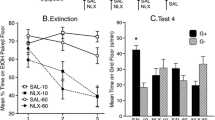Abstract
Rationale
Early ethanol exposure promotes ethanol reinforcement, mediated perhaps by ethanol’s motivational effects. The opioid system mediates ethanol reinforcement, at least in part.
Objectives
Modulation of consummatory and seeking behaviors by the opioid system was tested in terms of ethanol or sucrose operant self-administration.
Methods
Wistar-derived infant rats were tested in an operant conditioning task. (1) Infants were trained on postnatal days (PDs) 14–17 to obtain 5% sucrose and 3.75% ethanol or water, and evaluated in an extinction session at PD 18. (2) Ethanol (3.75%) was used as reinforcer. At PDs 16–17, 6 h before operant task, pups were re-exposed to ethanol after naloxone injection (0 or 1 mg/kg). (3) Sucrose (5%) acted as reinforcer. Pups were re-exposed to sucrose after naloxone injection. (4) A PD 18 re-exposure trial in which pups were injected with naloxone and re-exposed to ethanol was added.
Results
Sucrose and ethanol promoted higher levels of operant responding than water during training and extinction. Re-exposure to ethanol preceded by naloxone decreased nose-poking. A similar profile was observed towards sucrose. No seeking behavior was observed in pups re-exposed to ethanol following naloxone injection during PDs 16–18.
Conclusions
Self-administration of ethanol was established in terms of operant responding in preweanling rats with no previous exposure to the drug. Pairing of naloxone with ethanol, at a point separate in time from operant responding, reduced ethanol reinforcement. This indicated participation of the opioid system in ethanol reinforcement. This effect seems not to be unique to ethanol but also is observable when sucrose acts as reinforcer.




Similar content being viewed by others
References
Abate P, Spear NE, Molina JC (2001) Fetal and infantile alcohol-mediated associative learning in the rat. Alcohol Clin Exp Res 25:989–998
Adams CD, Dickinson A (1981) Instrumental responding following reinforce devaluation. Q J Exp Psychol 33B:109–122
Arias C, Chotro MG (2005a) Increased palatability of ethanol after prenatal ethanol exposure is mediated by the opioid system. Pharmacol Biochem Behav 29:434–442
Arias C, Chotro MG (2005b) Increased preference for ethanol in the infant rat after prenatal ethanol exposure, expressed on intake and taste reactivity tests. Alcohol Clin Exp Res 29:337–346
Arias C, Mlewski EC, Molina JC, Spear NE (2009) Naloxone and baclofen attenuate ethanol's locomotor-activating effects in preweanling Sprague-Dawley rats. Behav Neurosci 123:172–180
Arias C, Molina JC, Spear NE (2010) Differential role of micro, delta and kappa opioid receptors in ethanol-mediated locomotor activation and ethanol intake in preweanling rats. Physiol Behav 99:348–354
Arnold HM, Robinson SR, Spear NE, Smotherman WP (1993) Conditioned opioid activity in the rat fetus. Behav Neurosci 107:963–969
Berridge KC, Robinson TE, Aldridge JW (2009) Dissecting components of reward: 'liking', 'wanting', and learning. Curr Opin Pharmacol 9:65–73
Bienkowski P, Kostowski W, Koros E (1999) Ethanol-reinforced behaviour in the rat: effects of naltrexone. Eur J Pharmacol 374:321–327
Blass EM, Shide DJ (1994) Some comparisons among the calming and pain-relieving effects of sucrose, glucose, fructose and lactose in infant rats. Chem Senses 19:239–249
Blass EM, Watt LB (1999) Suckling- and sucrose-induced analgesia in human newborns. Pain 83:611–623
Bordner KA, Molina JC, Spear NE (2008) Analysis of ethanol reinforcement in 1-day-old rats: assessment through a brief and novel operant procedure. Alcohol Clin Exp Res 32:1–13
Cheslock SJ, Varlinskaya EI, Petrov ES, Silveri MM, Spear LP, Spear NE (2001) Ethanol as a reinforcer in the newborn´s first suckling experience. Alcohol Clin Exp Res 25:391–402
Chotro MG, Arias C (2003) Prenatal exposure to ethanol increases ethanol consumption: a condiitoned response? Alcohol 30:19–28
Domínguez HD, Bocco G, Chotro MG, Spear NE, Molina JC (1993) Operant responding controlled by milk or milk contaminated with alcohol as a positive reinforcers in infant rats. Pharmacol Biochem Behav 44:403–409
Domínguez HD, López MF, Molina JC (1998) Neonatal responsiveness to alcohol odor and infant alcohol intake as a function of alcohol experience during late gestation. Alcohol 16:109–117
Fidler TL, Clews TW, Cunningham CL (2006) Reestablishing an intragastric ethanol self-infusion model in rats. Alcohol Clin Exp Res 30:414–428
Froehlich JC, Zweifel M, Harts J, Lumeng L, Li TK (1991) Importance of delta opioid receptors in maintaining high alcohol drinking. Psychopharmacology (Berl) 103:467–472
Gianoulakis C (2009) Endogenous opioids and addiction to alcohol and other drugs of abuse. Curr Top Med Chem 9:999–1015
Holson RR, Pearce B (1992) Principles and pitfalls in the analysis of prenatal treatment effects in multiparous species. Neurotoxicol Teratol 14:221–228
Hunt PS, Molina JC, Spear LP, Spear NE (1990) Ethanol-mediated taste aversions and state-dependency in preweanling (16-day-old) rats. Behav Neural Biol 54:300–322
Hunt PS, Molina JC, Rajachandran L, Spear LP, Spear NE (1993) Chronic administration of alcohol in the developing rat: expression of functional tolerance and alcohol olfactory aversions. Behav Neural Biol 59:87–99
Hyytia P, Kiianmaa K (2001) Suppression of ethanol responding by centrally administered CTOP and naltrindole in AA and Wistar rats. Alcohol Clin Exp Res 25:25–33
Kiefer SW, Hill KG, Coonfield DL, Ferraro FM 3rd (2005) Ethanol familiarity and naltrexone treatment affect ethanol responses in rats. Alcohol 37:167–172
Kraemer PJ, Hofmann H, Randall CK, Spear NE (1992) Devaluation of Pavlovian contitioning in the 10-day-old rat. Anim Learn Behav 20:219–222
Krishnan-Sarin S, Jing SL, Kurtz DL, Zweifel M, Portoghese PS, Li TK, Froehlich JC (1995) The delta opioid receptor antagonist naltrindole attenuates both alcohol and saccharin intake in rats selectively bred for alcohol preference. Psychopharmacology (Berl) 120:177–185
Lindholm S, Werme M, Brene S, Franck J (2001) The selective kappa-opioid receptor agonist U50,488H attenuates voluntary ethanol intake in the rat. Behav Brain Res 120:137–146
March SM, Abate P, Spear NE, Molina JC (2009) Fetal exposure to moderate ethanol doses: heightened operant responsiveness elicited by ethanol-related reinforcers. Alcohol Clin Exp Res 33:1981–1993
Miranda-Morales RS, Molina JC, Spear NE, Abate P (2010) Participation of the endogenous opioid system in the acquisition of a prenatal ethanol-related memory: effects on neonatal and preweanling responsiveness to ethanol. Physiol Behav 101:153–160
Molina JC, Chotro MG (1989a) Acute alcohol intoxication paired with aversive reinforcement: ethanol odor as a conditioned reinforcer in rat pups. Behav Neural Biol 52:1–19
Molina JC, Chotro MG (1989b) Acute alcohol intoxication paired with appetitive reinforcement: effects upon ethanol intake in infant rats. Behav Neural Biol 51:326–345
Molina JC, Chotro G, Spear NE (1989) Early (preweanling) recognition of alcohol's orosensory cues resulting from acute ethanol intoxication. Behav Neural Biol 51:307–325
Molina JC, Bannoura MD, Chotro MG, McKinzie DL, Arnold HM, Spear NE (1996) Alcohol-mediated tactile conditioned aversions in infant rats: devaluation of conditioning through alcohol-sucrose associations. Neurobiol Learn Mem 66:121–132
Molina JC, Ponce LF, Truxel E, Spear NE (2006) Infantile sensitivity to ethanol's motivational effects: ethanol reinforcement during the third postnatal week. Alcoho Clin Exp Res 30:1506–1519
Molina JC, Pautassi RM, Truxell E, Spear N (2007) Differential motivational properties of ethanol during early ontogeny as a function of dose and postadministration time. Alcohol 41:41–55
Nadorova AV, Kozlovskaja MM, Seredenin SB (2009) Naloxone effects on behavior of inbred mice with different response to emotional stress in open field test. Bull Exp Biol Med 148:609–611
National Research Council (2010) Guide for the care and use of laboratory animals. Washington, DC: National Academy Press.
Nizhnikov ME, Molina JC, Varlinskaya EI, Spear NE (2006a) Prenatal ethanol exposure increases ethanol reinforcement in neonatal rats. Alcohol Clin Exp Res 30:34–45
Nizhnikov ME, Varlinskaya EI, Petrov ES, Spear NE (2006b) Reinforcing properties of ethanol in neonatal rats: involvement of the opioid system. Behav Neurosci 120:267–280
Nizhnikov ME, Pautassi RM, Truxell E, Spear NE (2009) Opioid antagonists block the acquisition of ethanol-mediated conditioned tactile preference in infant rats. Alcohol 43:347–358
Pautassi RM, Godoy JC, Spear NE, Molina JC (2002) Early responsiveness to stimuli paired with different stages within the state of alcohol intoxication. Alcohol Clin Exp Res 26:644–654
Pautassi RM, Molina JC, Spear N (2008a) Infant rats exhibit aversive learning mediated by ethanol's orosensory effects but are positively reinforced by ethanol's post-ingestive effects. Pharmacol Biochem Behav 88:393–402
Pautassi RM, Truxell E, Molina JC, Spear NE (2008b) Motivational effects of intraorally-infused ethanol in rat pups in an operant self-administration task. Physiol Behav 93:118–129
Pautassi RM, Nizhnikov ME, Spear NE (2009) Assessing appetitive, aversive, and negative ethanol-mediated reinforcement through an immature rat model. Neurosci Biobehav Rev 33:953–974
Pautassi RM, Nizhnikov ME, Acevedo MB, Spear NE (2011) Naloxone blocks ethanol-mediated appetitive conditioning and locomotor activation in adolescent rats. Behav Brain Res 216:262–269
Pepino MY, Kraebel KS, López MF, Spear NE, Molina JC (1998) Behavioral detection of low concentrations of ethanol in the preweanling rat. Alcohol 15:337–353
Pepino MY, López MF, Spear NE, Molina JC (1999) Infant rats respond differently to alcohol after nursing from an alcohol-intoxicated dam. Alcohol 18:189–201
Petrov ES, Varlinskaya EI, Spear NE (2001) Self-administration of ethanol and saccharin in newborn rats: effects on suckling plasticity. Behav Neurosci 115:1318–1331
Petrov ES, Varlinskaya EI, Spear NE (2003) Reinforcement from pharmacological effects of ethanol in newborn rats. Alcoho Clin Exp Res 27:1583–1591
Ponce LF, Pautassi RM, Spear NE, Molina JC (2006) Ethanol reinforcing properties during infancy in the rat: operant self-administration of the drug. Alcohol Clin Exp Res 30:186A
Ponce LF, Pautassi RM, Spear NE, Molina JC (2008) Ethanol-mediated operant learning in the infant rat leads to increased ethanol intake during adolescence. Pharmacol Biochem Behav 90:640–650
Samson HH, Czachowski CL (2003) Behavioral measures of alcohol self-administration and intake control: rodent models. Int Rev Neurobiol 54:107–153
Samson HH, Cunningham CL, Czachowski CL, Chappell A, Legg B, Shannon E (2004) Devaluation of ethanol reinforcement. Alcohol 32:203–212
Sanders S, Spear NE (2007) Ethanol acceptance is high during early infancy and becomes still higher after previous ethanol ingestion. Alcohol Clin Exp Res 31:1148–1158
Sharpe AL, Samson HH (2001) Effect of naloxone on appetitive and consummatory phases of ethanol self-administration. Alcohol Clin Exp Res 25:1006–1011
Spear NE, Molina JC (2005) Fetal or infantile exposure to ethanol promotes ethanol ingestion in adolescence and adulthood: a theoretical review. Alcohol Clin Exp Res 29:909–929
Spear NE, Specht SM, Kirstein CL, Kuhn CM (1989) Anterior and posterior, but not cheek, intraoral cannulation procedures elevate serum corticosterone levels in neonatal rat pups. Dev Psychobiol 22:401–412
Truxell E, Spear NE (2004) Immediate acceptance of ethanol in infant rats: ontogenetic differences with moderate but not high ethanol concentration. Alcohol Clin Exp Res 28:1200–1211
Varlinskaya EI, Petrov ES, Cheslock SJ, Spear NE (1999) A new model of ethanol self-administration in newborn rats: gender effects on ethanol ingestion through a surrogate nipple. Alcohol Clin Exp Res 23:1368–1376
Volterra A, Brunello N, Restani P, Galli CL, Racagni G (1986) Ontogenetic studies on mu, delta and kappa opioid receptors in rat brain. Pharmacol Res Commun 18:979–990
Acknowledgments
This work was supported by the Agencia Nacional de Promoción Científica y Tecnológica (PICT 38080, P.A.), PICT 254 (J.C.M.), Secretaría de Ciencia y Tecnología (SECyT, P.A.), Consejo Nacional de Investigaciones Científicas y Técnicas (PIP–CONICET, P.A.), the U.S. National Institute on Alcohol Abuse and Alcoholism (AA11960, AA015992, and AA013098, N.E.S.), the U.S. National Institute of Mental Health (MH035219, N.E.S), and a fellowship from CONICET (to R.S.M.M.). R.S.M.M. is a student of the Ph.D. program of Doctorado en Ciencias Biológicas (F.C.E.F. y N.–U.N.C.). We also gratefully acknowledge Aceitera General Deheza S.A.
Author information
Authors and Affiliations
Corresponding author
Rights and permissions
About this article
Cite this article
Miranda-Morales, R.S., Molina, J.C., Spear, N.E. et al. Naloxone attenuation of ethanol-reinforced operant responding in infant rats in a re-exposure paradigm. Psychopharmacology 219, 235–246 (2012). https://doi.org/10.1007/s00213-011-2402-5
Received:
Accepted:
Published:
Issue Date:
DOI: https://doi.org/10.1007/s00213-011-2402-5




